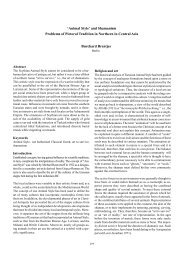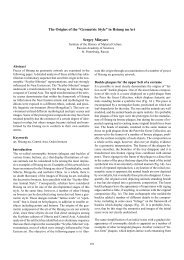Part II Archaeological Excavations - Center for the Study of Eurasian ...
Part II Archaeological Excavations - Center for the Study of Eurasian ...
Part II Archaeological Excavations - Center for the Study of Eurasian ...
Create successful ePaper yourself
Turn your PDF publications into a flip-book with our unique Google optimized e-Paper software.
Kurgans, Ritual Sites, and Settlements: <strong>Eurasian</strong> Bronze and Iron Age<br />
northwards to <strong>the</strong> small-leafed <strong>for</strong>ests, and is represented by<br />
multi-grass meadows and birch-aspen coppices. To <strong>the</strong> south<br />
<strong>of</strong> <strong>the</strong> <strong>for</strong>est-steppes, <strong>the</strong> steppes are composed <strong>of</strong> multi-grass<br />
and fea<strong>the</strong>r-grass vegetation that until recently has been <strong>the</strong><br />
predominant ground cover. As a whole, <strong>the</strong> landscape <strong>of</strong> <strong>the</strong><br />
Ural-Siberian <strong>for</strong>est-steppe is characterized by alternating geographic<br />
zones and a mosaic distribution <strong>of</strong> vegetation–<strong>for</strong>ests<br />
meadows, swamps, and steppes.<br />
The largest part <strong>of</strong> <strong>the</strong> area under study geographically belongs<br />
to <strong>the</strong> Tobol province, and is characterized by a slightly elevated,<br />
undulating surface which has many lakes. A very important<br />
factor <strong>of</strong> <strong>the</strong> Transural relief is <strong>the</strong> riverine valleys, principally<br />
<strong>the</strong> Tobol, Iset, Miass; all <strong>of</strong> which have rich soils. In<br />
<strong>the</strong> Tobol valleys, rich vegetation is associated with alluvial<br />
soils. The ancient Tobol terraces are characterized by a predominance<br />
<strong>of</strong> saline soils with <strong>the</strong>ir corresponding types <strong>of</strong> flora.<br />
On <strong>the</strong> high terraces <strong>the</strong> sandy soils are covered by coniferous<br />
and birch trees. Aspen groves and small birch <strong>for</strong>ests consume<br />
over 60% <strong>of</strong> <strong>the</strong> surface in <strong>the</strong> nor<strong>the</strong>rn <strong>for</strong>est-steppe and not<br />
more than 5% in <strong>the</strong> south. In <strong>the</strong> drained areas, hawthorn is<br />
pr<strong>of</strong>use, and several kinds <strong>of</strong> cherry trees, wild roses, honeysuckle,<br />
rowan trees, and currants grow. In <strong>the</strong> hills, where some<br />
<strong>of</strong> <strong>the</strong> initial steppe land is preserved, <strong>the</strong> black soils are covered<br />
with meadows, an abundance <strong>of</strong> bean plants, meadowsweet<br />
grass, different varieties <strong>of</strong> cereals, wormwood, and tarragon.<br />
The fauna is mixed and both <strong>for</strong>est and steppe species <strong>of</strong> animals<br />
are found, including elk and bear and, until recently, large<br />
numbers <strong>of</strong> beavers, wolves, steppe antelopes, roe deer, wild<br />
pigs, foxes, and o<strong>the</strong>r animals.<br />
The environments described above and <strong>the</strong> botanical areas<br />
currently found in <strong>the</strong> region had already <strong>for</strong>med by <strong>the</strong><br />
beginning <strong>of</strong> <strong>the</strong> Iron Age. These areas were especially favorable<br />
<strong>for</strong> livestock breeding–<strong>the</strong> basis <strong>of</strong> subsistence <strong>for</strong><br />
<strong>the</strong> local populations–especially during <strong>the</strong> Iron Age. The<br />
bones <strong>of</strong> <strong>the</strong>se livestock animals are well represented in all<br />
<strong>of</strong> <strong>the</strong> excavated sites.<br />
According to some Russian specialists, <strong>the</strong> climatic and landscape<br />
conditions <strong>of</strong> <strong>the</strong> Holocene changed several times. It is<br />
considered that at least three climatic fluctuations occurred from<br />
<strong>the</strong> third to <strong>the</strong> first millennia BC. During <strong>the</strong> second half <strong>of</strong><br />
<strong>the</strong> third millennium BC, and at <strong>the</strong> turn <strong>of</strong> <strong>the</strong> second and <strong>the</strong><br />
first millennia BC, periods <strong>of</strong> high precipitation dominated.<br />
Low precipitation apparently occurred from <strong>the</strong> middle <strong>of</strong> <strong>the</strong><br />
second millennium BC onwards.<br />
During <strong>the</strong> late prehistoric period, <strong>the</strong> above-described landscapes<br />
were occupied by cultures <strong>of</strong> different social levels<br />
and economic orientation–<strong>the</strong>se consisted <strong>of</strong> nomads, seminomads,<br />
settled pastoralists, specialists in metallurgy, and<br />
hunters and fishers. Their linguistic attributions were distinct,<br />
and <strong>the</strong>y are assumed to have been proto-Iranian and<br />
proto-Ugrian speakers. Compared with <strong>the</strong> populations that<br />
occupied <strong>the</strong> core <strong>Eurasian</strong> steppes, <strong>the</strong> tribes that occupied<br />
<strong>the</strong> areas <strong>of</strong> marginal contact with <strong>the</strong> <strong>for</strong>est-steppe<br />
peoples are much less understood.<br />
64<br />
Chronological frames and cultural context<br />
The temporal sequence we are dealing with extends through<br />
<strong>the</strong> first millennium BC through to <strong>the</strong> beginning <strong>of</strong> <strong>the</strong> first<br />
millennium AD. The project is focused mainly on <strong>the</strong> Sargat<br />
Culture which occupies <strong>the</strong> area between <strong>the</strong> Ural Mountains<br />
and <strong>the</strong> Baraba lowlands. The project also includes several subcultures–<strong>the</strong><br />
Gorokhovo, <strong>the</strong> Itkul, and <strong>the</strong> Baitovo–as well as<br />
cultural types–<strong>the</strong> Kashino and <strong>the</strong> Prygovo. These cultures<br />
and sub-cultures are archaeologically represented by various<br />
<strong>for</strong>tified and open settlements as well as by numerous kurgans<br />
(barrows).<br />
The end <strong>of</strong> <strong>the</strong> Bronze Age during <strong>the</strong> 8th century BC witnessed<br />
<strong>the</strong> <strong>for</strong>mation <strong>of</strong> metallurgical centers in <strong>the</strong> Urals, with<br />
<strong>the</strong> Ananyino center in <strong>the</strong> west and <strong>the</strong> Itkul center in <strong>the</strong> east.<br />
These two centers were ra<strong>the</strong>r closely connected and had a common<br />
foundation, but <strong>the</strong>ir spheres <strong>of</strong> influence differed. The<br />
Ananyino center lay mostly within <strong>the</strong> Scythian cultural zone,<br />
while <strong>the</strong> Itkul center was more closely connected to <strong>the</strong> Saka,<br />
<strong>the</strong> Sauromatian, and <strong>the</strong> Sargat zones.<br />
Despite influence from <strong>the</strong> north, <strong>the</strong> Tobol-Irtysh <strong>for</strong>est-steppe<br />
region became one <strong>of</strong> <strong>the</strong> principal components <strong>of</strong> <strong>the</strong> cultural<br />
and economic system which extended to Middle Asia and <strong>the</strong><br />
Kazakhstan steppes. This predetermined <strong>the</strong> future contacts that<br />
local chiefdoms made with <strong>the</strong> Middle Asian states, and with<br />
<strong>the</strong> <strong>Eurasian</strong> steppe nomadic confederations. A very unique flexible<br />
mechanism <strong>of</strong> cultural genesis had been determined. Innovations<br />
were syn<strong>the</strong>sized without prejudice to local cultural<br />
originality (Koryakova and Epimakhov <strong>for</strong>thcoming).<br />
Research strategy<br />
The research strategy used in this study was based upon <strong>the</strong><br />
combination <strong>of</strong> multidisciplinary investigations that included<br />
<strong>the</strong> excavation <strong>of</strong> basic settlements and cemeteries, and <strong>the</strong><br />
subsequent analyses <strong>of</strong> <strong>the</strong> excavations. The research team consisted<br />
<strong>of</strong> specialists in archaeology, topography, and aerial photographic<br />
analysis, paleoanthropology, environmental sciences<br />
(paleozoology and sedimentology), and <strong>the</strong> study <strong>of</strong> pottery.<br />
The excavations included intensive site evaluations through<br />
non-destructive methods that included aerial photography and<br />
topographic surveys, and trenching, in addition to large-scale<br />
excavations that were as extensive as possible depending upon<br />
time and financial resources.<br />
Practical results<br />
The joint excavation and multidisciplinary analysis <strong>of</strong> five cemeteries<br />
(which contained aristocratic and ordinary burials) and<br />
four settlements (including both permanent and temporary sites)<br />
was partly accomplished over a period <strong>of</strong> six years (Table 1).<br />
Chronologically, <strong>the</strong> sites covered <strong>the</strong> continuous time period<br />
from <strong>the</strong> 7th century BC to <strong>the</strong> 3rd century AD. Some Late<br />
Bronze Age and Medieval structures were also included in <strong>the</strong><br />
research programme (Koryakova and Daire <strong>for</strong>thcoming).<br />
Space does not permit <strong>the</strong> presentation <strong>of</strong> <strong>the</strong> complete site<br />
data, but particular structures encountered at two <strong>of</strong> <strong>the</strong> excavated<br />
sites are discussed below.





